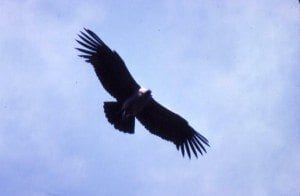Grand Canyon Experts | A Conversation with Wildlife Biologist, Chris Parish
Q: I understand you are a wildlife biologist specializing in birds of prey, how long have you done this?
A: I have been with the program since 1997, as a biologist for both the game and fish departments. I started in November of 2000 with the release program.
Q: What kinds of birds of prey can be found in the Grand Canyon?
A: Condors, hawks and eagles. During migration, red tail, zone tail hawks, owls, turkey

Grand Canyon Condor
vultures, peregrine falcons, prairie falcons, and many others.
Q: I understand that you release Condors into the wild. Can you explain this process?
A: All birds that are released in the program come from the captive breeding programs. The birds are birthed and nurtured and as they grow they are put in acclimation pens for a while. Behavior is then evaluated until they are deemed for release. Transmitters and number tags are used to track the birds after their release.
Q: What made releasing Condors into the wild a necessity? What contributed to the dwindling of their population?
A: Many factors contributed, especially lead poisoning. This is still the number one cause of death for condors. This comes from animals that have been shot with ammunition made with lead. The birds feed on the remains of the animal and get poisoned from the contaminated ammunition. They’ve asked hunters to use non-lead ammunition to prevent the problem. More than 87% of hunters on the Kaibab Plateau used non-lead ammunition last year with more than 80 percent using non-lead ammunition in the past four years.
Q: How often do you release these Condors into the wild and how many do you release at a time?
A: 10-12 per year
Q: Are these releases performed privately or are there spectators that are able to watch? If so, what type of questions do they ask you?
A: We have one Annual release, taking place on the third Saturday in September. Anyone can come out and watch. Today there are almost 400 birds, 200 in the wild. Otherwise, most of the releases aren’t too eventful. Basically what happens is the birds are in a type of pen, we open the pen, and they fly out as they please. The annual release is a hand release, where we actually let the birds go by hand.
Q: Where do the birds go once released?
A: There is a 70-mile radius home range from the release site. Biologists in the region monitor them through the imbedded transmitters and wing tags. The birds all tend to stay within the 70 mile radius.
Q: On what type of animals do Condors feed? Are there enough of them to sustain the food chain?
A: They eat mostly deer, elk, cattle and sheep.
Q: Are Condors preyed upon by some other animal? If so, what animal(s)?
A: They are preyed upon by golden eagles, coyotes and humans.
Q: Do you lead any tours our conduct any shows for Grand Canyon Visitors?
A: I conduct scheduled presentations for both individuals and groups.
Q: How much longer do you think captive breeding of Condors will be necessary?
A: 13 young have produced in the wild so far and we are hoping wild reproduction will pick up. As soon as they can lower lead poisoning the population will grow. The ultimate goal is a self sustaining population of Condors. We must reduce the amount of lead exposed to condors.
Q: How many species of Condors are there and what are the differences?
A: There are two different species of Condor, the first being the California Condor, which is found in North America, primarily the southwestern states of Arizona, Nevada, and California and also in Mexico. The California Condor is the type of Condor I breed and release. The other species is the Andean Condor, found primarily in Central and South Americas, particularly in the Andes Mountains. Both birds are scavengers – the only real difference between the two is the Andean is slightly larger than the California, and its color patterns are different.



